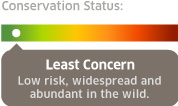Appearance:
Leopard geckos are cream to olive-yellow in color. They have black spots or stripes similar to a leopard's marking. Their thick skin provides protection against rough sand and rocky terrain, and they have small nails for climbing twigs and rocks. Unlike most geckos, leopard geckos have eyelids. This helps keep their eyes clean from dusty environments. Additionally, unlike most geckos, leopard geckos have claws instead of stick pads on their feet. They have the best vision of any gecko or type of lizard, and they can see almost as well as a cat.
Size:
6-12 inches long. Males are generally larger than females.
Diet:
Insects, arachnids and other lizards
Reproduction:
Breeding season runs from January to August/September. Females can store sperm, so they're able to lay two fertilized eggs every month for four to five months. Incubation lasts 52 days. Sex of the hatchlings is determined by the incubation temperature. Eggs at 80-84ºF will produce females; 88-90ºF will produce males. Eggs above 90ºF will produce “hot females” which are more aggressive than other females and are usually infertile. Offspring reach sexual maturity at 18 months.
Behavior:
These nocturnal reptiles are solitary, and they spend their days burrowed underground or hiding under rocks. Males are territorial. Geckos can detach their tails to escape from predators. Tails grow back, typically shorter, smoother and more bulbous then before.
Median Life Expectancy:
Up to 10 years
Habitat/Range:
Rocky deserts and sparse grasslands; mountains up to altitudes of 2,100 meters above sea level.
Range: Pakistan, Western India, Afghanistan, and parts of Iran.



